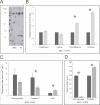Adaptive iron utilization compensates for the lack of an inducible uptake system in Naegleria fowleri and represents a potential target for therapeutic intervention
- PMID: 32555641
- PMCID: PMC7326272
- DOI: 10.1371/journal.pntd.0007759
Adaptive iron utilization compensates for the lack of an inducible uptake system in Naegleria fowleri and represents a potential target for therapeutic intervention
Abstract
Naegleria fowleri is a single-cell organism living in warm freshwater that can become a deadly human pathogen known as a brain-eating amoeba. The condition caused by N. fowleri, primary amoebic meningoencephalitis, is usually a fatal infection of the brain with rapid and severe onset. Iron is a common element on earth and a crucial cofactor for all living organisms. However, its bioavailable form can be scarce in certain niches, where it becomes a factor that limits growth. To obtain iron, many pathogens use different machineries to exploit an iron-withholding strategy that has evolved in mammals and is important to host-parasite interactions. The present study demonstrates the importance of iron in the biology of N. fowleri and explores the plausibility of exploiting iron as a potential target for therapeutic intervention. We used different biochemical and analytical methods to explore the effect of decreased iron availability on the cellular processes of the amoeba. We show that, under iron starvation, nonessential, iron-dependent, mostly cytosolic pathways in N. fowleri are downregulated, while the metal is utilized in the mitochondria to maintain vital respiratory processes. Surprisingly, N. fowleri fails to respond to acute shortages of iron by inducing the reductive iron uptake system that seems to be the main iron-obtaining strategy of the parasite. Our findings suggest that iron restriction may be used to slow the progression of infection, which may make the difference between life and death for patients.
Conflict of interest statement
The authors have declared that no competing interests exist.
Figures



References
-
- De Jonckheere JF. What do we know by now about the genus Naegleria? Exp Parasitol. 2014. November;145(S):S2–9. - PubMed
-
- Kelly RB, Francine M-C, Charles PG. Occurrence of Naegleria fowleri in Arizona drinking water supply wells. J Am Water Works Assoc. 2009. November;101(11):43–50.
-
- Ma P, Visvesvara GS, Martinez AJ, Theodore FH, Daggett PM, Sawyer TK. Naegleria and acanthamoeba infections: Review. Clin Infect Dis. 1990. May 1;12(3):490–513. - PubMed
Publication types
MeSH terms
Substances
LinkOut - more resources
Full Text Sources
Medical

